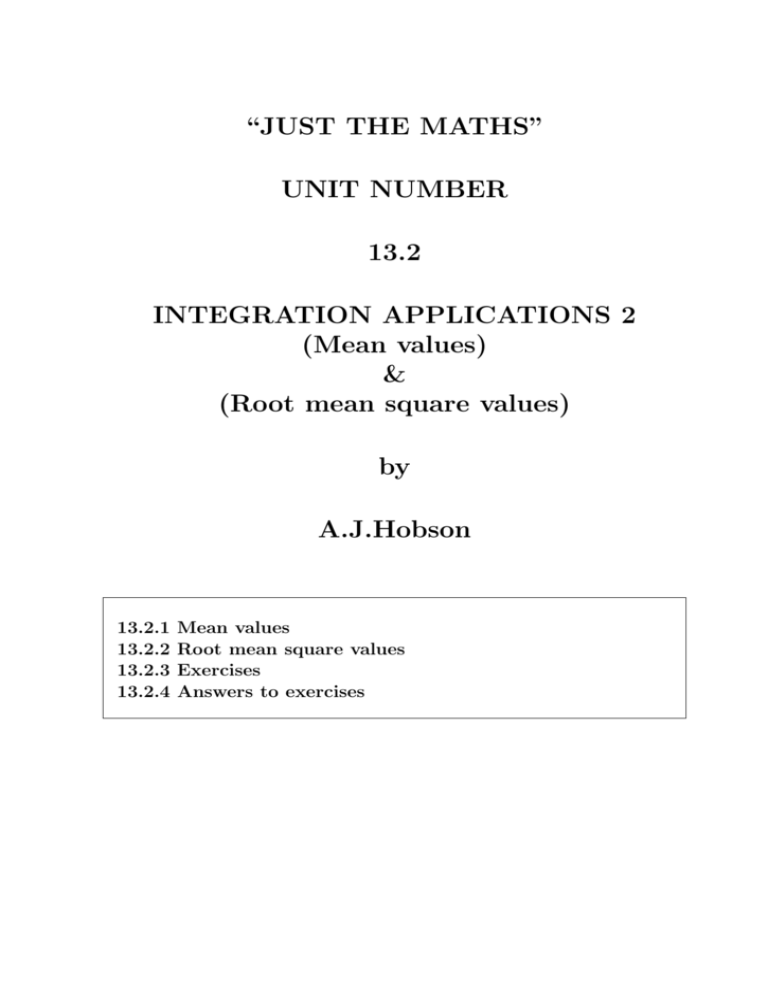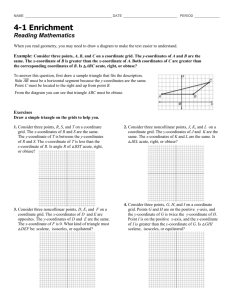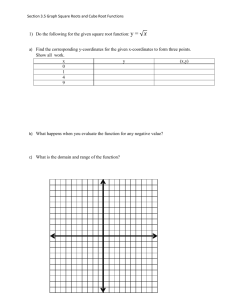integration applications 2
advertisement

“JUST THE MATHS” UNIT NUMBER 13.2 INTEGRATION APPLICATIONS 2 (Mean values) & (Root mean square values) by A.J.Hobson 13.2.1 13.2.2 13.2.3 13.2.4 Mean values Root mean square values Exercises Answers to exercises UNIT 13.2 - INTEGRATION APPLICATIONS 2 MEAN AND ROOT MEAN SQUARE VALUES 13.2.1 MEAN VALUES y 6 yn O y1 a -x b On the curve whose equation is y = f (x), suppose that y1 , y2 , y3 , ......, yn are the y-coordinates which correspond to n different x-coordinates, a = x1 , x2 , x3 , ......, xn = b. The average (that is, the arithmetic mean) of these n y-coordinates is y1 + y2 + y3 + ...... + yn . n But now suppose that we wished to determine the average (arithmetic mean) of all the y-coordinates, from x = a to x = b on the curve whose equation is y = f (x). We could make a reasonable approximation by taking a very large number, n, of y-coordinates separated in the x-direction by very small distances. If these distances are typically represented by δx, then the required mean value could be written y1 δx + y2 δx + y3 δx + ...... + yn δx , nδx 1 in which the denominator is equivalent to (b − a + δx), since there are only n − 1 spaces between the n y-coordinates. Allowing the number of y-coordinates to increase indefinitely, δx will to tend to zero and we obtain the formula for the “Mean Value” in the form x=b X 1 lim yδx. M.V. = b − a δx→0 x=a That is, 1 Zb M.V. = f (x) dx. b−a a Note: In cases where the definite integral in this formula represents the area between the curve and the x-axis, the Mean Value provides the height of a rectangle, with base b − a, having the same area as that represented by the definite integral. EXAMPLE Determine the Mean Value of the function f (x) ≡ x2 − 5x from x = 1 to x = 4. Solution The Mean Value is given by 1 Z4 2 1 x3 5x2 M.V. = (x − 5x) dx = − 4−1 1 3 3 2 " 1 3 64 1 5 − 40 − − 3 3 2 2 =− 33 . 2 #4 = 1 13.2.2 ROOT MEAN SQUARE VALUES It is sometimes convenient to use an alternative kind of average for the values of a function, f (x), between x = a and x = b. The “Root Mean Square Value” provides a measure of “central tendency” for the numerical values of f (x) and is defined to be the square root of the Mean Value of f (x) from x = a to x = b. Hence, s R.M.S.V. = 1 Zb [f (x)]2 dx. b−a a EXAMPLE Determine the Root Mean Square Value of the function, f (x) ≡ x2 − 5, from x = 1 to x = 3. Solution The Root Mean Square Value is given by s R.M.S.V. = 1 Z3 2 (x − 5)2 dx. 3−1 1 Temporarily ignoring the square root, we obtain the “Mean Square Value”, M.S.V. = 1 x5 10x3 = − + 25x 2 5 3 " #3 1 1 = 2 1Z 3 4 (x − 10x2 + 25) dx 2 1 243 270 1 10 − + 75 − − + 25 5 3 5 3 Thus, s R.M.S.V. = 3 176 ' 2.422 30 = 176 . 30 13.2.3 EXERCISES 1. (a) Determine the Mean Value of the function, (x − 1)(x − 2), from x = 1 to x = 2; (b) Determine, correct to three significant figures, the Mean Value of the function, 1 2x+5 , from x = 3 to x = 5; (c) Determine the Mean Value of the function, sin 2t, from t = 0 to t = π2 ; (d) Determine, correct to three places of decimals, the Mean Value of the function, e−x , from x = 1 to x = 5; (e) Determine, correct to three significant figures, the mean value of the function, xe−2x , from x = 0 to x = 2. 2. (a) Determine the Root Mean Square Value of the function, 3x + 1, from x = −2 to x = 2; (b) Determine the Root Mean Square Value, of the function, ex , from x = 0 to x = 1, correct to three decimal places; (c) Determine the Root Mean Square Value of the function, cos x, from x = 3 2 π 2 to x = π; (d) Determine the Root Mean Square Value of the function, (4x − 5) , from x = 1.25 to x = 1.5. 13.2.4 ANSWERS TO EXERCISES 1. (a) − 16 ; (b) 0.0775; (c) π2 ; (d) −0.076; (e) 0.114 √ 2. (a) 13 '= 3.606; (b) 1.787; (c) √12 ; (d) 12 . 4










